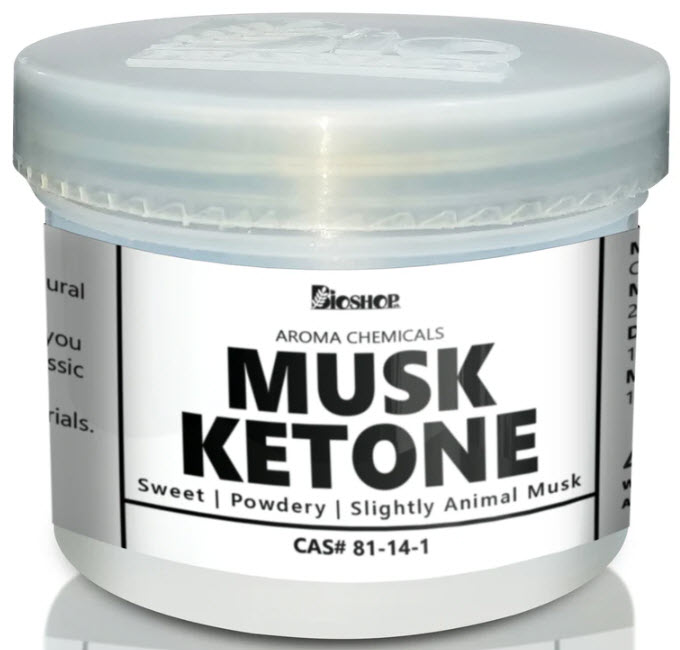Musk Ketone is a synthetic musk compound widely used in perfumery for its soft, powdery, and musky scent. It is one of the classic nitro musks, which were among the first synthetic musks developed in the late 19th and early 20th centuries. Below is a detailed explanation of Musk Ketone, including its properties, uses, and significance in perfumery.

1. Chemical Structure and Properties
- Chemical Name: Musk Ketone
- IUPAC Name: 3,5-Dinitro-2,6-dimethyl-4-tert-butylacetophenone
- Molecular Formula: C₁₄H₁₈N₂O₅
- Molecular Weight: 294.31 g/mol
- Appearance: A white to pale yellow crystalline solid.
- Odor: Soft, powdery, musky, and slightly sweet with a warm, skin-like quality.
- Solubility: Insoluble in water but soluble in alcohol and oils, making it suitable for use in perfumes and cosmetic formulations.
- Melting Point: Approximately 135–137°C (275–279°F).
- Stability: Stable under normal conditions but can degrade under strong acids, bases, or UV light.
2. Discovery and Development
Musk Ketone was first synthesized in the late 19th century as part of the development of nitro musks, which were created to mimic the scent of natural musk derived from the musk deer. Nitro musks, including Musk Ketone, were widely used in the early 20th century due to their affordability and unique scent profiles. However, due to safety concerns and regulatory restrictions, their use has declined in favor of other synthetic musks like polycyclic and macrocyclic musks.
3. Role in Perfumery
Musk Ketone is a versatile fragrance ingredient with several key roles:
- Base Note: It is often used as a base note in perfumes, providing a long-lasting, soft, and musky foundation.
- Blending Agent: It harmonizes well with other musky, floral, and powdery notes, creating a balanced and smooth scent profile.
- Fixative: It helps stabilize and prolong the scent of a perfume by slowing down the evaporation of more volatile components.
- Skin-like Quality: It adds a warm, velvety, and intimate quality to fragrances, making them feel more personal and sensual.
4. Fragrance Profile
Musk Ketone contributes the following olfactory characteristics to a perfume:
- Musky: Adds a soft, warm, and animalic muskiness.
- Powdery: Imparts a gentle, talcum-like powderiness.
- Sweet: Provides a subtle, honey-like sweetness.
- Warm: Creates a cozy, skin-like, and intimate quality.
5. Common Uses in Perfumes
Musk Ketone is a staple in many fragrance families, including:
- Floral Fragrances: It is a key component in floral perfumes, particularly those featuring powdery and musky notes like violet, iris, and rose.
- Oriental Fragrances: Its warm and sweet qualities make it ideal for oriental and amber compositions.
- Powdery Fragrances: Its soft and powdery character makes it ideal for vintage and skin-scented perfumes.
- Functional Fragrances: It is widely used in soaps, detergents, and household cleaners due to its pleasant and long-lasting scent.
6. Safety and Regulation
Musk Ketone has been subject to regulatory scrutiny due to concerns about its potential environmental persistence and bioaccumulation. Key points include:
- IFRA Compliance: The International Fragrance Association (IFRA) has set guidelines for the maximum allowable concentration of Musk Ketone in different product types to ensure safety.
- Restrictions: Due to safety concerns, its use has been restricted or banned in some formulations, particularly in leave-on products like perfumes and lotions.
- Alternative Musks: Many perfumers now use polycyclic or macrocyclic musks as safer alternatives to nitro musks like Musk Ketone.
7. Advantages in Perfumery
- Versatility: It blends well with a wide range of fragrance materials, including florals, powders, and ambers.
- Longevity: Its fixative properties help prolong the lifespan of a perfume on the skin.
- Warmth and Sensuality: Its soft and skin-like qualities make it ideal for creating intimate and sensual fragrances.
8. Limitations
- Regulatory Restrictions: Compliance with IFRA and EU regulations has limited its use in certain formulations.
- Environmental Concerns: Its potential for bioaccumulation and environmental persistence has led to a decline in its use.
9. Example Perfumes Featuring Musk Ketone
Musk Ketone has been used in numerous iconic fragrances, including:
- Chanel No. 5: Enhances the powdery and musky base.
- Shalimar by Guerlain: Complements the warm and oriental accords.
- Narciso Rodriguez for Her: Adds a soft and sensual muskiness to the floral composition.
10. Conclusion
Musk Ketone is a classic aroma chemical in perfumery, prized for its soft, powdery, and musky characteristics. Its ability to act as a base note, fixative, and blending agent makes it indispensable in creating warm, intimate, and long-lasting fragrances. However, due to safety and environmental concerns, its use has declined in favor of alternative synthetic musks. Its versatility and unique scent profile ensure its continued prominence in vintage and classic fragrances.